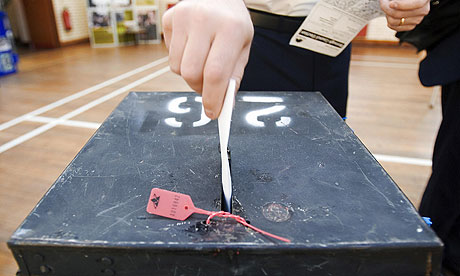Switch to AV would not boost BNP chances, says thinktank
IPPR says research shows influence of BNP would not be enhanced under the alternative vote system
- guardian.co.uk,
- Article history

A move to the alternative vote system would not hand undue influence to the BNP, according to research done by the IPPR Photograph: Leon Neal/AFP/Getty Images
A move to the alternative vote system would not hand undue influence to the BNP, according to research done by the IPPR that looked at results in all constituencies if the last election had been run under AV. Researchers at the thinktank have run a series of tests on two different facets of the claim by those who oppose the move to AV that the BNP would be able to "pick a winner". The IPPR looks at whether there could be a mass transfer of BNP supporters' votes pushing one candidate over the 50% threshold, and that BNP voters' second preferences could overturn a favourite and help someone placed second or even third to come first. The research comes as both the no and yes campaigns prepare to mark the four-week countdown to the AV referendum. The no campaign has aired concerns that a change in the voting system would boost minority parties, with their campaign director, Matthew Elliott, saying recently AV would "[give] BNP supporters more power at the ballot box". In an AV system, voters rank candidates instead of voting only for their chosen one. If no single candidate has secured 50% of the vote immediately, the candidate who has received fewest first preference votes is eliminated and the second preferences of their voters are redistributed to other candidates. The no campaign fears the second preferences of those eliminated – likely to be those who back minority parties – could go on to have profound effects further down the reallocation process. They have published a list of 35 seats in which the BNP's share of the vote was greater than the winner's margin of victory. Now researchers have looked at this assertion in two ways. They show there to be 56 seats where the share of the BNP vote exceeds the gap between the first-placed candidate and the 50% threshold they need to cross and where, if all BNP supporters transferred their second preferences as a bloc, could help the lead candidate win. They then show that the 2010 British election survey – which asked 13,356 people to take part in a mock election run under their AV system – found the number of seats where the second preference of those voting BNP push a winning candidate over the 50% threshold fell to 25. However, the IPPR researchers show that in all 25 seats the second preferences of the BNP are not "decisive" and the second preferences of others just as critical. They show that in the 25, the first-placed candidate is within "spitting distance" of the finishing line and the average gap between the first and second placed candidate is 24.52%, which they say is "larger than the share of the vote of any third-placed candidate whose votes would be needed to change the result". "In other words there is no chance that BNP second preference votes could alter the outcome in any of these seats. In all of them the winner on first preferences will be the winner once votes have been reallocated in subsequent rounds irrespective of the role played by BNP votes." The IPPR researchers also dissect the idea that BNP voters could change the balance of power in constituencies by pushing a second or third place candidate into first place and over the 50% threshold on the back of its transferred votes. Results from the 2010 election show that there is not one constituency where the BNP vote share is larger than the margin between 50% and that received by the runner-up. Their researchers say: "Given the marginality and distance from 50% for both the first and second placed candidates it is true that BNP supporters' second or third preferences will be counted in the 35 seats listed by the 'No to AV' campaign. "However, the BNP vote is still very small in each of these seats, averaging a vote share of just 4.5% – yet the average distance from 50% for the winning candidate is 11.3% and 14.2% for the runner-up. Even if we assume all BNP preferences go to a single candidate (which they wouldn't) they would still require more than twice the number of BNP supporters to win under AV. BNP voters cannot therefore single-handedly change a result." The IPPR details some high profile cases:
No comments:
Post a Comment